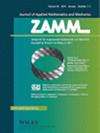Bioconvection flow of Prandtl–Eyring nanofluid in the presence of gyrotactic microorganisms
IF 3.2
4区 工程技术
Q1 MATHEMATICS, APPLIED
Zamm-zeitschrift Fur Angewandte Mathematik Und Mechanik
Pub Date : 2023-09-14
DOI:10.1002/zamm.202300358
引用次数: 0
Abstract
Abstract This work presents a theoretical numerical study of the bioconvection flow of Prandtl–Eyring nanofluid through a stretching cylinder with gyrotactic microorganisms. The mathematical model developed also incorporated the inclined magnetic field and heat generation effects. Further, stratification conditions are considered at the boundary of the stretched cylinder. The described flow problem conducting coupled high‐order partial differential equations (PDEs) is first reduced to the nonlinear system of ordinary differential equations (ODEs) by introducing suitable mathematical transformations. The resulting highly nonlinear flow equations are treated numerically by applying the shooting method. A comparison of the adapted method with previously reported data is also made to validate the presented results. The comparisons are in excellent agreement. The individual effect of controlling flow parameters/numbers on the flow profiles and physical quantities of engineering interest are represented graphically with physical descriptions. The significant results of the present analysis revealed that a rise in bioconvection Rayleigh number, thermal Grashof number, and angle of inclination boosts the velocity profile. The study shows that thermal stratification, mass stratification, and motile density stratification parameters diminish the temperature, concentration, and microorganism profiles, respectively. The nondimensional Sherwood number is decelerated significantly by thermophoresis and mass stratification parameters.陀螺仪微生物存在下Prandtl-Eyring纳米流体的生物对流流动
摘要本文对Prandtl-Eyring纳米流体在带有陀螺致动微生物的拉伸圆柱体中的生物对流流动进行了理论数值研究。所建立的数学模型还考虑了倾斜磁场和发热效应。此外,在拉伸圆柱体的边界处考虑分层条件。本文首先通过引入适当的数学变换,将耦合高阶偏微分方程(PDEs)的流动问题简化为非线性常微分方程(ode)系统。采用射击法对所得的高度非线性流动方程进行了数值处理。还将调整后的方法与先前报道的数据进行了比较,以验证所提出的结果。这些比较是非常一致的。控制流动参数/数量对工程感兴趣的流动剖面和物理量的个别影响用物理描述图形表示。分析结果表明,生物对流瑞利数、热格拉什夫数和倾角的增加会增加速度剖面。研究表明,热分层、质量分层和运动密度分层参数分别降低了温度、浓度和微生物分布。无量纲舍伍德数受到热泳和质量分层参数的显著影响。
本文章由计算机程序翻译,如有差异,请以英文原文为准。
求助全文
约1分钟内获得全文
求助全文
来源期刊
CiteScore
3.30
自引率
8.70%
发文量
199
审稿时长
3.0 months
期刊介绍:
ZAMM is one of the oldest journals in the field of applied mathematics and mechanics and is read by scientists all over the world. The aim and scope of ZAMM is the publication of new results and review articles and information on applied mathematics (mainly numerical mathematics and various applications of analysis, in particular numerical aspects of differential and integral equations), on the entire field of theoretical and applied mechanics (solid mechanics, fluid mechanics, thermodynamics). ZAMM is also open to essential contributions on mathematics in industrial applications.

 求助内容:
求助内容: 应助结果提醒方式:
应助结果提醒方式:


